- home
- Dried Seafood
- Processing of Dried Scallop
Processing of Dried Scallop
The key to the successful processing of dried scallop is in achieving uniformity of quality.
The process starts with meticulous control of the freshness of harvested scallops. The production processes have detailed requirements and processing control is applied with expert technology that finetunes the processes to adapt to weather and scallop conditions. The finished product is guaranteed in quality and safety by inspection and grading conducted by the Hokkaido Federation of Fisheries Cooperative Associations. All of these above are essential elements in ensuring that the dried scallops from Hokkaido is of the world’s topmost quality.
① Delivery & Storage of Raw Scallops
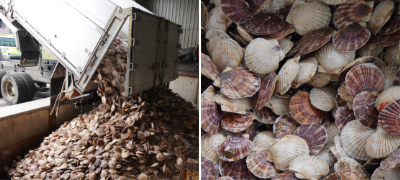
Raw scallops are delivered into refrigerated tanks. Depending on ambient temperature, crushed ice is also used to maintain freshness by keeping the temperature of the raw scallop tank below a designated level.
② Cleaning and First Boil

The scallops are washed to remove foreign matter such as sand that may be adhering to them. In order to make the shells open easily, the scallops are boiled, but only for the minimum time required for the opening up of shells. Either a boiler system or steamer system is used. In the boiler system, the clouding of the boiling water is controlled by water replacement at a specific ratio.
③ Shelling and Cooling/Cleaning
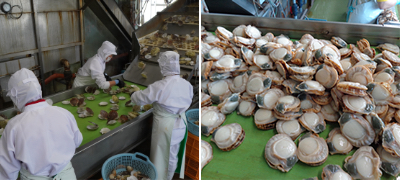
The scallops are separated into shell and boiled flesh by shelling machines and human hand.
Then, the scallops are cooled and their surfaces are cleaned by washing.
④ Gutting/cleaning

The internal organs (e.g. mantle, uro) are removed from the scallops, with due care not to damage the adductor muscles. Because delicate maneuvers are required, this process is carried out completely by hand, carefully one by one.
The separated adductor muscles are again cleaned of surface contamination and roughly sorted by size.
⑤ Second Boil
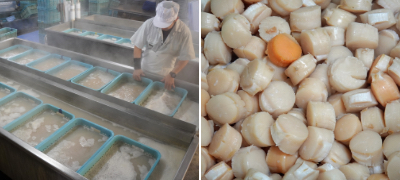
The adductor muscles that have been sorted according to size are boiled for evenness of heat/flavor, in line with salt levels and boiling time prescribed in detail for each size category. Changes in salt levels and clouding of the boiling water are monitored carefully and processing control of boiling water is finetuned, with the water being replaced as required.
⑥ Oven Drying

After boiling, the scallops are moved to small tray racks and cooled, then placed in the oven where they are roasted under high temperature for a set time according to size. Careful process control and adjustments are made so that all the scallops are dried evenly, for example adjusting by the position of racks.
⑦ Drying/Resting for moisture balancing

After cooling, the scallops are transferred to large tray racks and dried under the sun or by machine. Once a specific surface dryness is achieved, the scallops are laid out to rest in wooden containers so that the moisture gets evenly distributed on the surface and throughout the flesh.
These drying and resting processes are repeated several times, with minute adjustments made to the number of times and lengths of time according to the size and condition of the scallops as well as temperature and weather conditions. It sometimes takes nearly one month to complete this stage of processing.
⑧ Sorting/Trimming


Dried scallops are sorted by size and grade in accordance with the stipulated product standards.
During this stage, the scallops are checked for shell fragments or calcium contained in the scallops in the form of small deposits attaching to the flesh. As necessary, these deposits are trimmed using small knives. This is painstaking work but a very important part of the process requiring great skill and expertise.
⑩ Inspection/Packaging
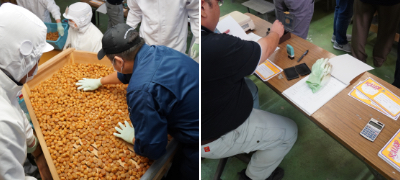
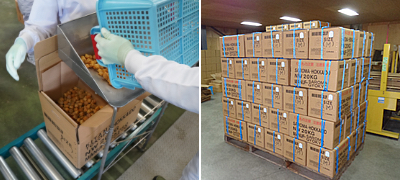
Inspectors from the Hokkaido Federation of Fisheries Cooperative Associations attend the packaging to inspect and grade the products. Each carton is packed with 2 lots of 10kg packs, and a Grading Card and safety certification label are inserted to finalize the product packaging.









